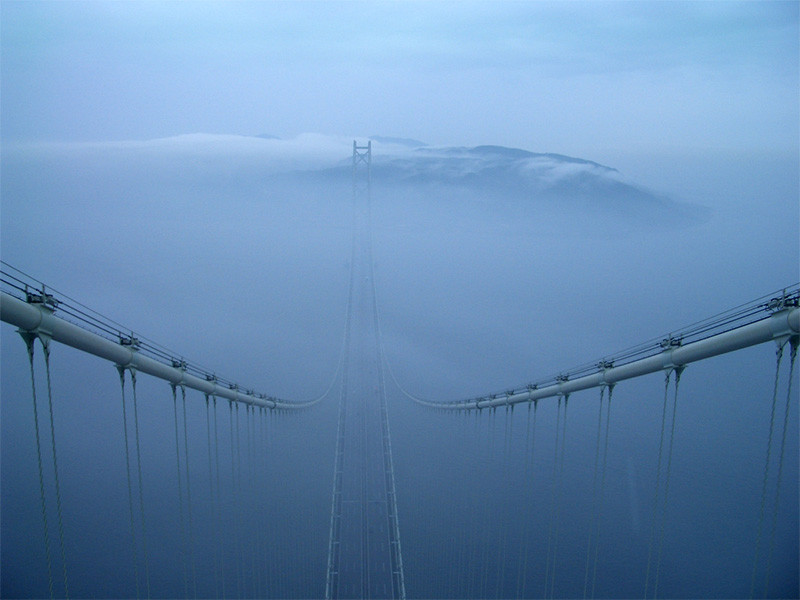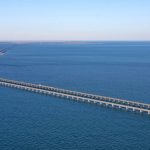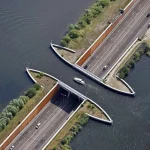The Akashi Kaikyo Bridge is a suspension bridge 3,911 meters (12,831.03 feet) long that connects Honshu (Japan’s main island) with Awaji Island. The Akashi Kaikyo Bridge, at almost 4 kilometers (2.49 miles), is the longest suspension bridge in Japan (second in the world and first until 2022), spanning the Akashi Strait to link the city of Kobe with Awaji-shima Island. The Akashi Kaikyo Bridge is not only long but also extremely tall. Its two towers, over 2,880 meters (9,449.48 feet) high, rise higher than any other tower of any bridge in the world.
| Location | Awaji City - Kobe City, Japan |
| Route name | National Route 28 |
| Start of construction | May 1988 |
| Open | April 1998 |
| Material | Steel |
| Full length | 12,831 ft (3,911 m) |
| Height | 977 feet (298 m) |

Construction
Construction of the bridge began in May 1988 and faced various challenges, including the 1995 Southern Hyogo Prefecture Earthquake, which caused the ground to shift and unexpectedly increased the bridge’s length by 1 meter. Despite these challenges, the bridge was completed and opened on April 5, 1998.
The Akashi Kaikyo Bridge crosses the Akashi Strait, one of the busiest straits in the world. Engineers had to design a bridge that wouldn’t block the barely resting maritime traffic. They also had to deal with the weather, as this area of Japan experiences very strong winds. It is also a very rainy area, and hurricanes, tsunamis, and earthquakes shake and lash the island almost annually.

How did the Japanese engineers solve these problems? They supported their bridge with a network of triangular trusses beneath the roadway. The open network of triangles makes the bridge very rigid but also allows the wind to blow through the structure. Additionally, engineers installed 20 tuned mass dampers (TMDs) on each tower. The TMDs rotate in the opposite direction to the wind. So when the wind hits the bridge in one direction, the TMDs swing in the opposite direction, balancing the bridge and canceling out the sway. With this design, the Akashi Kaikyo can withstand winds of 250 kilometers per hour (155.34 miles per hour) and can withstand an earthquake with a magnitude of up to 8.5 on the Richter scale.

The Akashi Kaikyo bridge effect
Akashi Kaikyo Bridge is not just a marvel of engineering; it also has significant historical and economic implications. The idea for a bridge across the Akashi Strait existed before World War II but faced challenges due to technical limitations and wartime priorities. It wasn’t until 1970 that the Honshu-Shikoku Connecting Bridge Corporation was established, marking the beginning of serious efforts to build the bridge.

The bridge also had implications for the Shikoku Shinkansen. Originally, there were plans to include a railway component in the bridge’s design, but technical challenges and financial constraints led to the decision to make it a road-only bridge. This decision influenced the development of transportation infrastructure in the region, highlighting the complexities of balancing engineering, economics, and societal needs in large-scale infrastructure projects.
The Akashi Kaikyo Bridge has had a profound impact on transportation and commerce in the region. With its opening, land-based travel between Honshu, Awaji, and Shikoku became much more convenient, leading to shifts in transportation patterns. Notably, ferry services saw a decline in passengers, and expressway buses became a popular mode of travel between these regions.
The Akashi Kaikyo bridge location
Soaring above the Akashi Strait, the Akashi Kaikyo Bridge stands as a testament to human ingenuity and the power of collaboration. This engineering marvel not only conquered technical hurdles but also revolutionized transportation, shaping the lives of millions. Standing on its deck, one can’t help but be awestruck by its scale and the breathtaking views it offers. As we look to the future, the Akashi Kaikyo Bridge reminds us that with determination and innovation, even the seemingly impossible can be achieved. Perhaps it’s time to look around and appreciate the engineering marvels that shape our world, inspiring us to dream bigger and build bolder.













